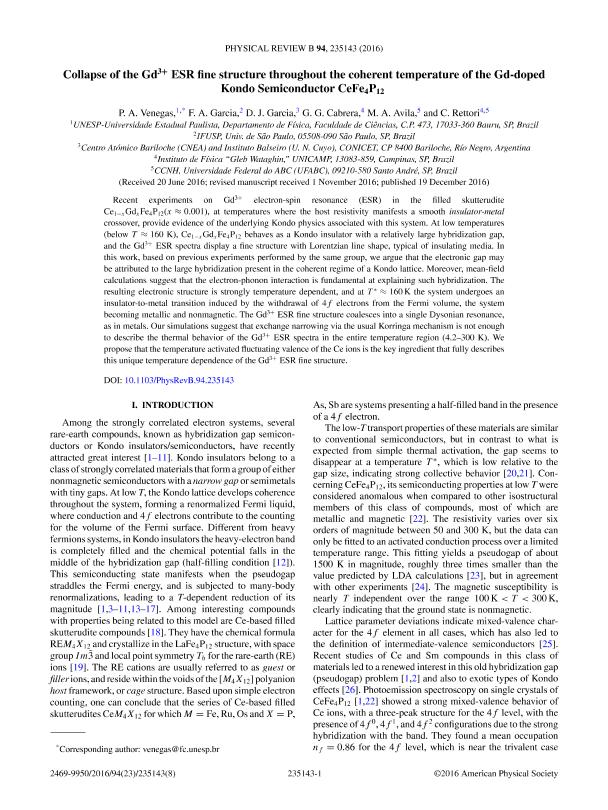Mostrar el registro sencillo del ítem
dc.contributor.author
Venegas, P. A.
dc.contributor.author
Garcia, F. A.
dc.contributor.author
Garcia, Daniel Julio

dc.contributor.author
Cabrera, G. G.
dc.contributor.author
Avila, M. A.
dc.contributor.author
Rettori, C.
dc.date.available
2018-12-10T15:20:31Z
dc.date.issued
2016-12-15
dc.identifier.citation
Venegas, P. A.; Garcia, F. A.; Garcia, Daniel Julio; Cabrera, G. G.; Avila, M. A.; et al.; Collapse of the G d 3 + ESR fine structure throughout the coherent temperature of the Gd-doped Kondo Semiconductor CeF e 4 P 12; American Physical Society; Physical Review B; 94; 23; 15-12-2016; 235143/1-8
dc.identifier.issn
2469-9969
dc.identifier.uri
http://hdl.handle.net/11336/66180
dc.description.abstract
Recent experiments on Gd3+ electron-spin resonance (ESR) in the filled skutterudite Ce1−xGdxFe4P12(x≈0.001), at temperatures where the host resistivity manifests a smooth insulator-metal crossover, provide evidence of the underlying Kondo physics associated with this system. At low temperatures (below T≈160 K), Ce1−xGdxFe4P12 behaves as a Kondo insulator with a relatively large hybridization gap, and the Gd3+ ESR spectra display a fine structure with Lorentzian line shape, typical of insulating media. In this work, based on previous experiments performed by the same group, we argue that the electronic gap may be attributed to the large hybridization present in the coherent regime of a Kondo lattice. Moreover, mean-field calculations suggest that the electron-phonon interaction is fundamental at explaining such hybridization. The resulting electronic structure is strongly temperature dependent, and at T∗≈160K the system undergoes an insulator-to-metal transition induced by the withdrawal of 4f electrons from the Fermi volume, the system becoming metallic and nonmagnetic. The Gd3+ ESR fine structure coalesces into a single Dysonian resonance, as in metals. Our simulations suggest that exchange narrowing via the usual Korringa mechanism is not enough to describe the thermal behavior of the Gd3+ ESR spectra in the entire temperature region (4.2–300 K). We propose that the temperature activated fluctuating valence of the Ce ions is the key ingredient that fully describes this unique temperature dependence of the Gd3+ ESR fine structure
dc.format
application/pdf
dc.language.iso
eng
dc.publisher
American Physical Society

dc.rights
info:eu-repo/semantics/openAccess
dc.rights.uri
https://creativecommons.org/licenses/by-nc-sa/2.5/ar/
dc.subject
Kondo Semiconductor
dc.subject
Esr
dc.subject
Insulator-Metal Crossover
dc.subject.classification
Astronomía

dc.subject.classification
Ciencias Físicas

dc.subject.classification
CIENCIAS NATURALES Y EXACTAS

dc.title
Collapse of the G d 3 + ESR fine structure throughout the coherent temperature of the Gd-doped Kondo Semiconductor CeF e 4 P 12
dc.type
info:eu-repo/semantics/article
dc.type
info:ar-repo/semantics/artículo
dc.type
info:eu-repo/semantics/publishedVersion
dc.date.updated
2018-11-22T14:53:23Z
dc.journal.volume
94
dc.journal.number
23
dc.journal.pagination
235143/1-8
dc.journal.pais
Estados Unidos

dc.journal.ciudad
Nueva York
dc.description.fil
Fil: Venegas, P. A.. Universidade Estadual Paulista Julio de Mesquita Filho; Brasil
dc.description.fil
Fil: Garcia, F. A.. Universidade de Sao Paulo; Brasil
dc.description.fil
Fil: Garcia, Daniel Julio. Consejo Nacional de Investigaciones Científicas y Técnicas. Centro Científico Tecnológico Conicet - Patagonia Norte; Argentina. Comisión Nacional de Energía Atómica. Centro Atómico Bariloche; Argentina. Comisión Nacional de Energía Atómica. Gerencia del Área de Energía Nuclear. Instituto Balseiro; Argentina
dc.description.fil
Fil: Cabrera, G. G.. Universidad Estatal de Campinas; Brasil
dc.description.fil
Fil: Avila, M. A.. Universidade Federal Do Abc; Brasil
dc.description.fil
Fil: Rettori, C.. Universidad Estatal de Campinas; Brasil. Universidade Federal Do Abc; Brasil
dc.journal.title
Physical Review B

dc.relation.alternativeid
info:eu-repo/semantics/altIdentifier/url/https://journals.aps.org/prb/abstract/10.1103/PhysRevB.94.235143
dc.relation.alternativeid
info:eu-repo/semantics/altIdentifier/doi/https://dx.doi.org/10.1103/PhysRevB.94.235143
Archivos asociados
